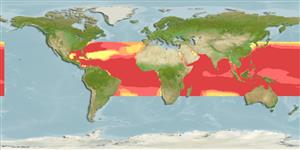Environment: milieu / climate zone / depth range / distribution range
Écologie
marin; océanodrome (Ref. 51243); profondeur 0 - 20 m. Subtropical; 40°N - 25°S
Indo-West Pacific: Red Sea and South Africa (including the Mascarenes, Ref. 33390) to southern Japan, Taiwan, Mariana, Caroline and Solomon islands, Queensland and the Arafura Sea (Ref. 9819). Western Atlantic: New Jersey, USA and northern Gulf of Mexico (Ref. 7251) to Rio de Janeiro, Brazil. Eastern Atlantic: Guinea to Gabon.
Taille / Poids / Âge
Maturity: Lm ? range ? - ? cm
Max length : 40.0 cm TL mâle / non sexé; (Ref. 5217); common length : 25.0 cm TL mâle / non sexé; (Ref. 5217)
Épines dorsales (Total) : 0; Rayons mous dorsaux (Total) : 12 - 14; Épines anales: 0; Rayons mous anaux: 9 - 11. Body dark, iridescent blue dorsally, silvery white below; pectorals bluish black; dorsal fin with prominent black spot (Ref. 2797).
Inhabits both neritic and oceanic surface waters (Ref. 30573). Capable of leaping out of the water and gliding for long distances above the surface (Ref. 30573). Feeds mostly on crustaceans and other planktonic organisms; often attracted to lights at night (Ref. 2797).
Life cycle and mating behavior
Maturities | Reproduction | Spawnings | Egg(s) | Fecundities | Larves
Parin, N.V., 1996. On the species composition of flying fishes (Exocoetidae) in the West-Central part of tropical Pacific. J. Ichthyol. 36(5):357-364. (Ref. 27313)
Statut dans la liste rouge de l'IUCN (Ref. 130435)
Menace pour l'homme
Harmless
Utilisations par l'homme
Pêcheries: intérêt commercial mineur
Outils
Articles particuliers
Télécharger en XML
Sources Internet
Estimates based on models
Preferred temperature (Ref.
123201): 21.7 - 29.1, mean 27.5 °C (based on 25528 cells).
Phylogenetic diversity index (Ref.
82804): PD
50 = 0.5000 [Uniqueness, from 0.5 = low to 2.0 = high].
Bayesian length-weight: a=0.00646 (0.00292 - 0.01429), b=3.04 (2.84 - 3.24), in cm total length, based on LWR estimates for this (Sub)family-body shape (Ref.
93245).
Niveau trophique (Ref.
69278): 3.3 ±0.38 se; based on food items.
Generation time: 1.3 ( na - na) years. Estimated as median ln(3)/K based on 1
growth studies.
Résilience (Ref.
120179): Haut, temps minimum de doublement de population inférieur à 15 mois (K=0.8).
Fishing Vulnerability (Ref.
59153): Low vulnerability (21 of 100).
Nutrients (Ref.
124155): Calcium = 218 [80, 440] mg/100g; Iron = 1.79 [0.91, 4.06] mg/100g; Protein = 17.7 [15.6, 19.6] %; Omega3 = 0.307 [0.140, 0.848] g/100g; Selenium = 22 [10, 47] μg/100g; VitaminA = 15.5 [4.6, 60.0] μg/100g; Zinc = 0.902 [0.611, 1.376] mg/100g (wet weight);
